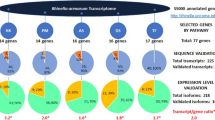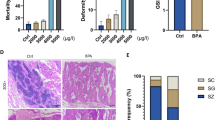Abstract
Endocrine disrupting chemicals (EDCs) alter the normal endocrine system of wildlife and humans. Among pesticides, a large number of chemicals have been identified as endocrine disruptors. Pesticides are designed to be toxic to pests and vectors of disease; however, human beings can easily be exposed to these chemicals because they are present in the environment at very low levels. In the present study, we examined the adverse effects of endocrine disrupting chemicals by screening transcripts and microRNAs. microRNAs are known as regulators of many protein coding genes. Therefore, the microRNAs regulating mRNAs were analyzed, including functional analysis. In addition, we tried to compare two types of chemicals, endocrine disruptor pesticides and EDCs. Endocrine disruptor pesticides were found to affect the reproductive or development systems by altering the Wnt signaling pathway, similar to EDCs. On the other hand, the genes involved in axon guidance and ubiquitin-mediated proteolysis were differentially regulated by treatment with endocrine disruptor pesticides compared with EDCs.
Similar content being viewed by others
References
Mostafalow, S. & Abdollahi, M. Pesticides and human chronic diseases: Evidences, mechanisms, and perspectives. Toxicol Appl Pharmacol 268:157–177 (2013).
Kanthasamy, A. et al. Emerging neurotoxic mechanisms in environmental factors-induced neurodegeneration. Neurotoxicology 33:833–837 (2012).
Migliore, L. & Coppede, F. Genetics, environmental factors and the emerging role of epigenetics in neurodegenerative diseases. Mutat Res 667:82–97 (2009).
Jurewicz, J. & Hanke, W. Prenatal and childhood exposure to pesticides and neurobehavioral development: review of epidemiological studies. Int J Occup Med Environ Health 21:121–132 (2008).
Dimanti-Kandarakis, E., Palioura, E., Kandarakis, S. A. & Koutsilieris, M. The impact of endocrine disruptors on endocrine targets. Horm Metab Res 42:543–552 (2010).
Schug, T. T., Janesick, A., Blumberg, B. & Heindel, J. J. Endocrine disrupting chemicals and disease susceptibility. J Steroid Biochem Mol Biol 127:204–215 (2011).
De Coster, S. & van Larebeke, N. Endocrine-disrupting chemicals: associated disorders and mechanisms of action. J Environ Public Health [Epub ahead of print] (2012).
Pickard, R. S., Powell, P. H. & Zar, M. A. The effect ofinhibitors of nitric oxide biosynthesis and cyclic GMP formation on nerve-evoked relaxation of human cavernosal smooth muscle. Br J Pharmacol 104:755–759 (1991).
Jiang, L., Huang, Q., Zhang, S., Zhang, Q. & Chang, J. Hsa-miR-125a-3p and hsa-miR-125a-5p are down-regulated in non-small cell lung cancer and have inverse effects on invasion and migration of lung cancer cells. BMC Cancer 10:318 (2010).
Katoh, M. WNT/PCP signaling pathway and human cancer. Oncol Rep 14:1583–1588 (2005).
Hsieh, I. S., Chang, K. C., Tsai, Y. T., Ke, J. Y. & Lu, P. J. MicroRNA-320 suppressed the stem cell like characteristics of prostate cancer cells by downregulating the Wnt/beta-catenin signaling pathway. Carcinogenesis 34:530–538 (2013).
Kurashige, J. et al. Overexpression of microRNA-223 regulates the ubiquitin ligase FBXW7 in oesophageal squamous cell carcinoma. Br J Cancer 106:182–188 (2012).
Smrt, R. D. et al. MicroRNA miR-137 regulates neuronal maturation by targeting ubiquitin ligase mind bomb-1. Stem Cells 28:1060–1070 (2010).
Mnif et al. Effect of Endocrine Disruptor Pesticides: A Review. Int J Environ Res Public Health 8:2265–2303 (2011).
Choi, H. S., Song, M. K., Lee, E. & Ryu, J. C. The toxicogenomic study on Persistent Organic Pollutants (POPs) in human hepatoma cell line. BioChip J 7:17–28 (2013).
Choi, H. S., Song, M. K. & Ryu, J. C. Integrated analysis of microRNA and mRNA expression profiles high-lights alterations in modulation of the apoptosis-related pathway under nonanal exposure. Mol Cell Toxicol 9:351–364 (2013).
Author information
Authors and Affiliations
Corresponding author
Additional information
These authors contributed equally to this work.
Rights and permissions
About this article
Cite this article
An, Y.R., Joo, Y.K., Kim, S.J. et al. Functional analysis of endocrine disruptor pesticides affected transcriptome and microRNA regulation in human hepatoma cell line. Mol. Cell. Toxicol. 10, 393–400 (2014). https://doi.org/10.1007/s13273-014-0044-5
Received:
Accepted:
Published:
Issue Date:
DOI: https://doi.org/10.1007/s13273-014-0044-5




